Barnard’s Loop is a large emission nebula within the Orion molecular cloud complex, a vast star-forming region located in the constellation Orion. The nebula appears as a large arc that loops around the stars of Orion’s Belt and Sword. It is believed to be ionized by the massive stars formed within the Orion Nebula.
Barnard’s Loop stretches across 10 degrees (600 arcminutes) of the sky and covers a good portion of the celestial Hunter. While it may be spotted visually under very dark skies, the nebula is best seen in long-exposure photographs. It has a visual magnitude of 5.
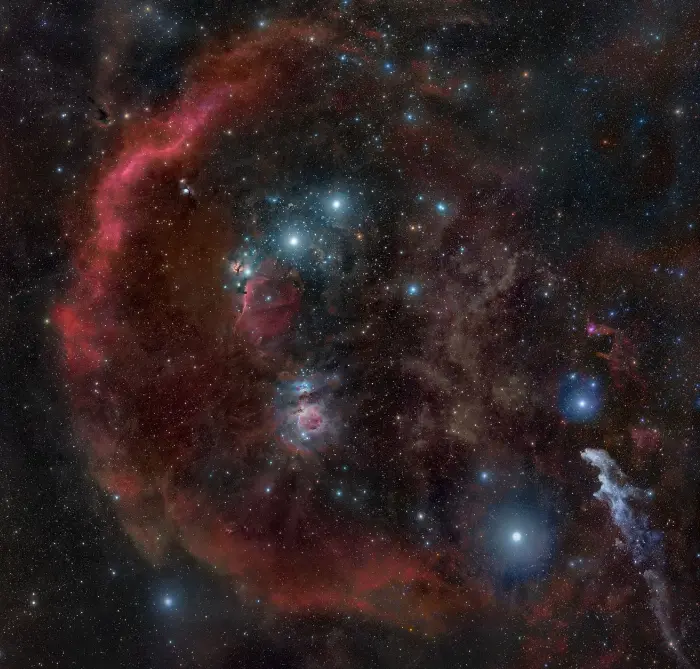
Barnard’s Loop (Sh2-276), image credit: Rogelio Bernal Andreo (CC BY-SA 3.0)
Barnard’s Loop is believed to have been formed after a supernova event that occurred approximately 2 million years ago. The same supernova may have expelled several known runaway stars, the hot blue AE Aurigae (which illuminates the Flaming Star Nebula in Auriga), Mu Columbae, and 53 Arietis.
The three stars and the supernova progenitor are believed to have been part of the same multiple-star system. The supernova event sent them speeding through space to their present locations.
The distance to Barnard’s Loop is uncertain. Recent estimates place the nebula either 518 light-years away or 1,434 light-years away. Depending on the distance, the nebula may have a physical size of 100 or 300 light-years. It has the catalogue designation Sh2-276 in the Sharpless catalogue of H II regions.
Barnard’s Loop is part of the Orion molecular cloud complex, a vast H II region that stretches hundreds of light-years across and lies between 1,000 and 1,400 light-years away. The Orion complex consists of two giant clouds of molecular hydrogen and is home to many emission nebulae, reflection nebulae, dark nebulae, and clusters of stars formed within the stellar nurseries of Orion.
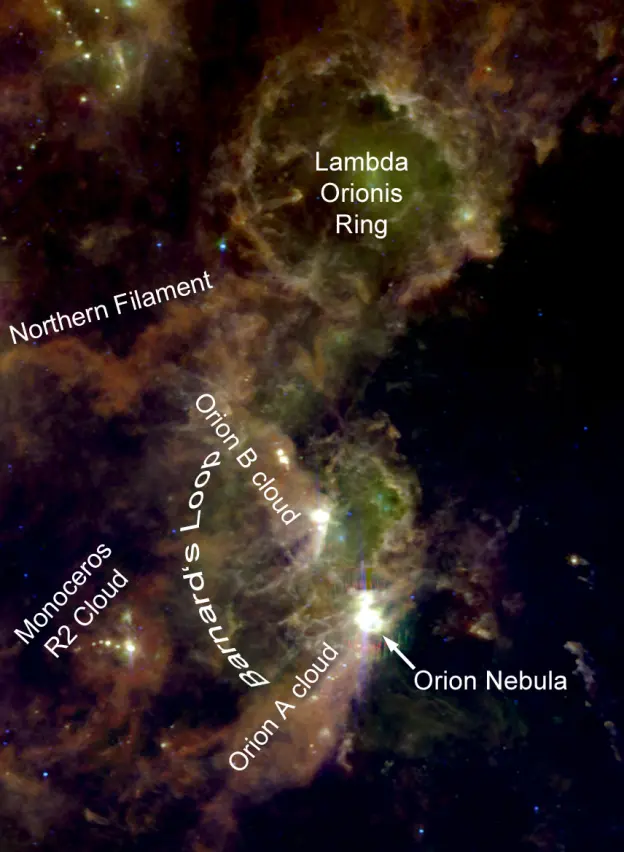
The regions of the Orion molecular cloud complex, image: Wikimedia Commons/Meli thev (CC BY-SA 4.0)
The complex hosts the bright Orion Nebula (Messier 42), the nearest region of massive star formation to Earth. It is also home to the Lambda Orionis Ring (Sharpless 264, the Angelfish Nebula), an H II region in the northern part of Orion ionized by the hot blue O-type giant Meissa (Lambda Orionis), the star that marks Orion’s head. Barnard’s Loop appears south of the Lambda Orionis Ring.
Barnard’s Loop was named after the American astronomer and astrophotographer Edward Emerson Barnard. Barnard was not the first person to observe the nebula, but he photographed and described it in 1894. The German-born British astronomer William Herschel may have been the first to spot the nebula in 1786.
E. E. Barnard described it as “an enormous curved nebulosity encircling the belt [of Orion] and the great nebula [Orion Nebula], and covering a large portion of the body of the giant. A description of this nebula would not only be complicated but it would fail, also, to give any impression of its form and magnitude; I have, therefore, made the enclosed drawing of it which will show at once its exact location and form.”
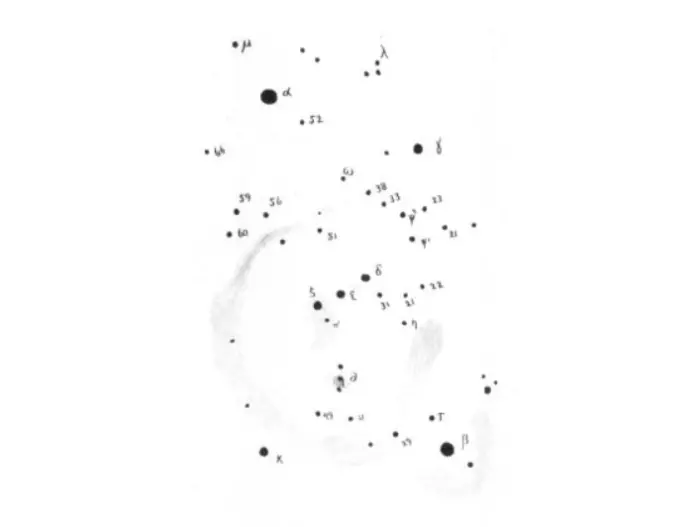
Barnard’s Loop by E. E. Barnard (1894), Popular Astronomy, Vol. 2, pp.151-154
E. E. Barnard was not the first to photograph Barnard’s Loop. American astronomer William Henry Pickering mentioned the nebula appearing on a plate in a paper published in Sidereal Messenger in January 1890.
Pickering wrote, “An interesting structure brought out upon our plates is a large spiral nebula whose outer extremity starts in the vicinity of γ Orionis [Bellatrix]. It passes about four degrees north of ζ [Alnitak], extends to γ thence to β [Rigel], then north to η, with an outside stream lying nearly north and south, and preceding β about four degrees. Another stream lying nearly east and west precedes η about the same amount. This nebula is about seventeen degrees in length, by nearly the same in breadth, and surrounds a cluster of bright stars including the belt and sword handle, and extending towards γ.”
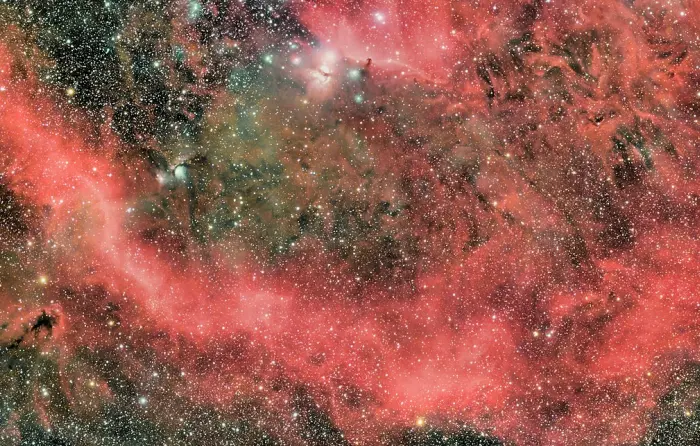
Barnard’s Loop, image credit: Giuseppe Donatiello (CC0 1.0)
The origin of Barnard’s Loop has puzzled astronomers for over a century. In 2022, a team led by Michael Foley of the Center for Astrophysics, Harvard & Smithsonian, used a 3D-mapping technique and provided evidence of a formation mechanism that may have produced the nebula. The team presented their findings at the 240th meeting of the American Astronomical Society in Pasadena, California, in June 2022.
Foley and his team suggested that the formation of Barnard’s Loop was associated with the supernovae that occurred in the region within the last 4 million years. They identified a cluster, OBP-B1, as the parent cluster of the supernova progenitors. The cluster lies near the centre of both Barnard’s Loop and a giant dust cavity whose edges border with several molecular clouds. The alignment of the molecular clouds indicates that most star-forming activity is found at the edge of the cavity, where it is triggered by the pressure waves of the supernova events. The supernovae that occurred within the last few million years would have swept up any dust in their paths and hollowed out the cavity.
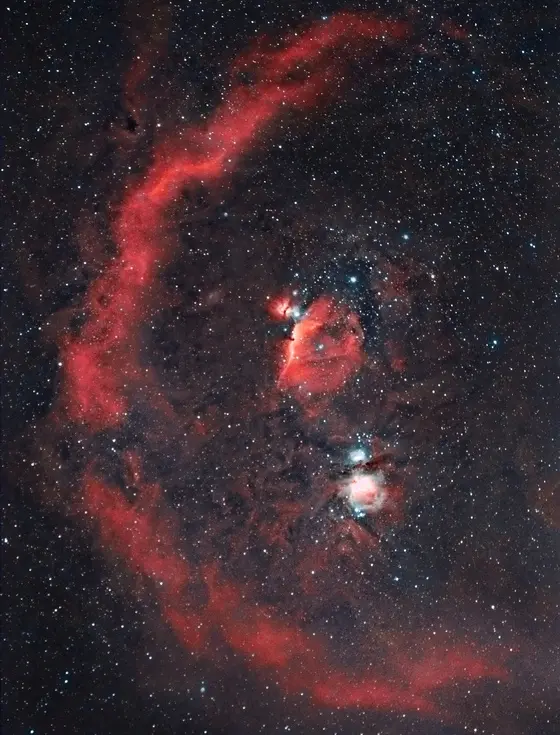
Barnard’s Loop, Orion’s Belt, Orion’s Sword and Orion Nebula. Taken with Canon 350D and 70-200L Lens. RGB and Hydrogen alpha light. Image credit: Wikimedia Commons/Hewholooks (CC BY-SA 3.0)
Location
Barnard’s Loop appears in the constellation of Orion, within the hourglass figure of the Hunter.
Orion is one of the most recognizable constellations in the sky. Its constellation figure is formed by seven exceptionally bright stars: Betelgeuse, Bellatrix, Rigel, Saiph, and the three stars of Orion’s Belt: Alnitak, Alnilam, and Mintaka.
Barnard’s Loop stretches from Bellatrix (Gamma Orionis) at Orion’s shoulder around Orion’s Belt in the direction of Rigel (Beta Orionis), the brightest star in Orion.
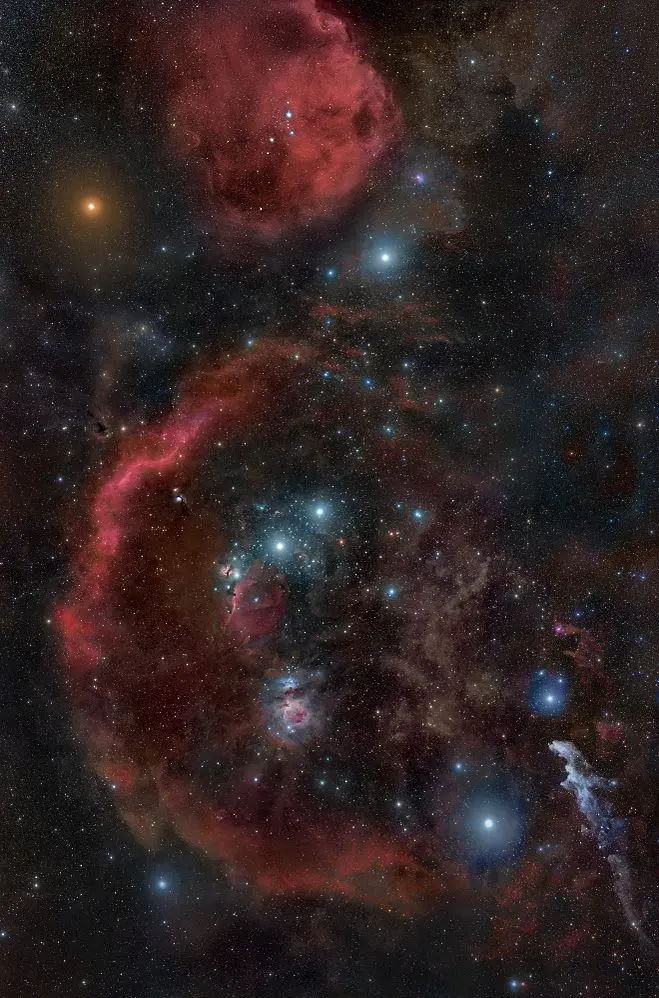
Photo taken by Rogelio Bernal Andreo in October 2010 of the Orion constellation showing the surrounding nebulas of the Orion molecular cloud complex. Also captured is the red supergiant Betelgeuse (top left), the Lambda Orionis Ring (top centre) and the famous Belt of Orion composed of the OB stars Alnitak, Alnilam and Mintaka. Rigel appears to the bottom right, next to the reflection nebula IC 2118 (the Witch Head Nebula). The red crescent shape is Barnard’s Loop. The photograph appeared as the Astronomy Picture of the Day on October 23, 2010. Image credit: Rogelio Bernal Andreo (CC BY-SA 3.0)
The nebula is usually too faint to be seen visually. Some of its gas may be seen in a telescope on a very clear, dark night, but the best way to see it is in wide-field long-exposure photographs of Orion.
Several bright Orion nebulae appear within Barnard’s Loop. The Flame Nebula (NGC 2024), the reflection nebula NGC 2023, and the dark Horsehead Nebula appear near Alnitak, the leftmost star of Orion’s Belt. The Running Man Nebula (Sh2-279), the Orion Nebula (M42), and De Mairan’s Nebula (M43) lie in the region of Orion’s Sword. The reflection nebula Messier 78 appears between Alnitak and Betelgeuse at the shoulder of Orion.
The best time of the year to observe Barnard’s Loop and other deep sky objects in Orion is during the northern hemisphere winter, when the celestial Hunter dominates the evening sky.
Barnard’s Loop – Sh2-276
| Constellation | Orion |
| Right ascension | 05h 27.5m |
| Declination | −03° 58′ |
| Apparent magnitude | 5 |
| Apparent size | 10 degrees |
| Distance | 518 light-years (159 parsecs) or 1,434 ly (440 pc) |
| Names and designations | Barnard’s Loop, Barnard’s Arc, Sh2-276 |